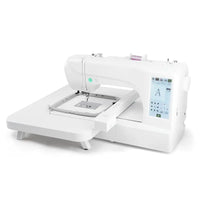Stretchy polyester fabrics can intimidate even seasoned embroiderers. This Ricoma video breaks down every step—from choosing a no-show cutaway stabilizer to hooping tension—to produce flawless, pucker-free stitches on performance wear. Learn the proven techniques that keep your embroidery soft, flexible, and professional-looking.
Table of Contents
- Understanding Stretchy Fabrics in Embroidery
- Choosing the Right Stabilizer for Performance Wear
- The Importance of Hoop Selection
- Needle Know-How: Ballpoint vs. Sharp Point
- Thread Considerations for Activewear
- The Magic of Temporary Adhesive Spray
- Step-by-Step Hooping and Embroidery Process
- Achieving Perfect Results: Finishing Touches
Understanding Stretchy Fabrics in Embroidery
Polyester knits and performance blends behave elastically, stretching in multiple directions. That makes them fantastic for activewear—but tricky for embroidery. The base fabric rebounds once unhooped, creating ripples known as puckering. Before diving into stitches, Ricoma’s host demonstrates these distortions using a plain polyester shirt

.
Common Challenges: Pinching and Puckering
Pull the fabric too tight, and stitches compress; too loose, and threads nest beneath the hoop. The sweet spot is steady yet relaxed tension

. It’s one reason many embroiderers explore improved frame systems such as magnetic hoops for brother embroidery machines for finer tension control while hooping comparable materials.
Choosing the Right Stabilizer for Performance Wear
The tutorial highlights the no-show cutaway stabilizer

. It’s lightweight, soft, and strong—perfect for delicate polys and knits. Heavier cutaways can make garments stiff or “blocky.”
Why No-Show Cutaway is Best
As seen in action, the soft mesh backing supports every stitch without adding visible bulk. Using one layer is sufficient; stacking layers defeats the fabric’s natural drape. Viewers confirmed this in comments, where Ricoma noted only a single sheet was used.
Balancing Support and Drape
Imagine an invisible structure that holds stitches yet flows like the garment itself. That’s the art of stabilization. Pairing softer backing with even hoop tension prevents distortion, especially for dense logos on athletic shirts. Crafters using commercial models—say a bai embroidery machine or similar—can apply identical stabilizer logic regardless of brand.
The Importance of Hoop Selection
A hoop slightly larger than usual minimizes inner-frame stretch

. With more fabric surface distributed around the rim, the center area resists deformation.
Going a Size Up
Larger hoops do more than comfort: they prevent “bounce-back” once the garment’s elasticity contracts post-stitch. Some embroiderers switch between plastic and magnetic frames like mighty hoops for ricoma when working with thick athletic materials because magnets give smooth hold without overtightening.
Minimizing Fabric Distortion
Whether you work on single-needle or multi-head machines, ensure consistency by checking tension across the hoop. A quick thumb press should reveal stability—not stretch.
Needle Know-How: Ballpoint vs. Sharp Point
The smallest detail—a rounded needle tip—makes or breaks stretch projects

. Ricoma specifies the 75/11 ballpoint, identified by FFG/SES when sourced from Groz-Beckert

.
Preventing Holes and Damage
Unlike sharps that pierce threads, ballpoints slip between fibers. The result: no snags, no visible holes. Comment threads show many beginners confuse sewing-machine “ballpoint” with embroidery-grade types; always verify it’s made for embroidery.
Identifying Groz-Beckert Ballpoint Needles
Those FFG/SES markings confirm the correct profile. It’s a reassuring sign on any system—from Ricoma setups to mighty hoops for brother pr1055x attachments—that your fabric stays intact through heavy runs.
Thread Considerations for Activewear
Polyester threads shine under repetitive cycles of washing, stretching, and UV exposure
. Ricoma used 40 wt on top, 60 wt in the bobbin. These weights deliver density without stiffness.
Durability with Polyester Thread
Polyester maintains colorfastness and flexibility better than viscose, making it ideal for fitness apparel. If you notice overly rigid results, check both thread weight and stitch density before switching materials.
The Magic of Temporary Adhesive Spray
To keep the soft knit steady, a gentle mist of Fast Tack 97 covers the stabilizer evenly

. Adhesive adds friction but no weight. The key lies in moderation—light coverage prevents gummy needles

.
Enhancing Stability During Hooping
This technique is ideal when hooping directly over curved or slippery textures. Larger production houses—even those using magnetic hoop for brother se2000 units—value spray methods for maintaining precision on flexible garments.
Step-by-Step Hooping and Embroidery Process
After applying adhesive, slide the stabilizer under the shirt

. Keep the surface smooth, then position the bottom ring. Lower the top gently without tugging. The balance between “not too tight” and “not too loose” defines success


.
Applying Adhesive and Positioning
A single piece of backer bonded lightly to fabric holds everything still until stitching completes.
Hooping without Overstretching
Leave stretch to the machine movement, not your hands. Flatten creases with fingers only—no pulling. Some prefer test tracing before stitching


.
Machine Setup and Tracing
Once the machine arm descends and traces the outline with its guide light, hit start

. That preview ensures alignment before needles drop.
Achieving Perfect Results: Finishing Touches
When stitching ends, release the hoop

. Trim stabilizer close—about three-quarters of an inch—to keep comfort against skin. After one wash, backing softens further, leaving a clean drape.
Careful Unhooping
Work slowly, letting the frame expand naturally before lifting fabric. Sudden motion can still stretch stitches.
Trimming the Stabilizer
Sharp scissors safeguard fabric edges. Mind that you never cut threads underneath.
The Final Look: No Puckering!
The finished shirt remains smooth, flexible, and professional—proof that careful preparation conquers even the trickiest athletic knits. Commenters attest results improve immediately once adopting ballpoint needles and balanced hooping.
> From the comments: Many crafters noted success replicating these tips on machines beyond Ricoma, including Brother and BAI models. The underlying principle stays universal: stabilize, hoop smart, and stitch gently.
Wrap-Up
Stretch fabrics require patience and awareness of tension. With these steps—proper stabilizer, larger hoop, ballpoint needle, and light adhesive—you achieve flawless embroidery that moves as gracefully as the garment itself.
If you’re experimenting on different machines or magnetic frames, explore systems like magnetic embroidery hoops for bernina or mighty hoops for tajima—the ergonomic principles mirror what Ricoma demonstrates here.
Happy stitching—and remember, flexible fabric deserves flexible thinking!



